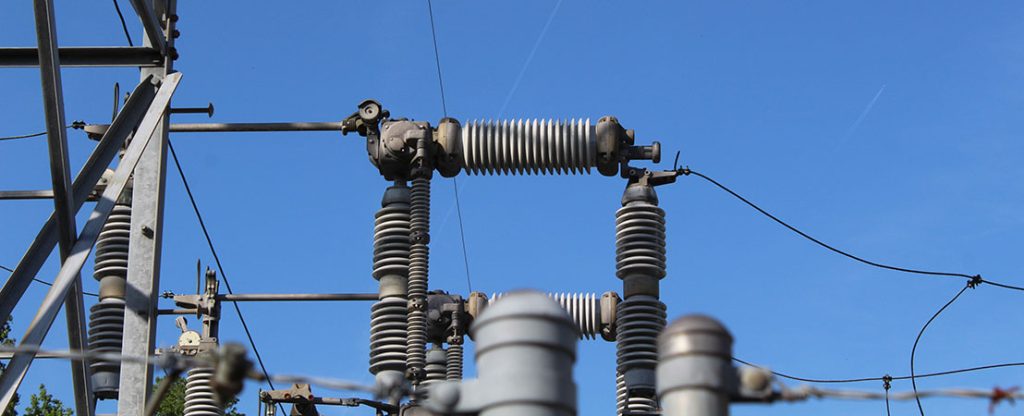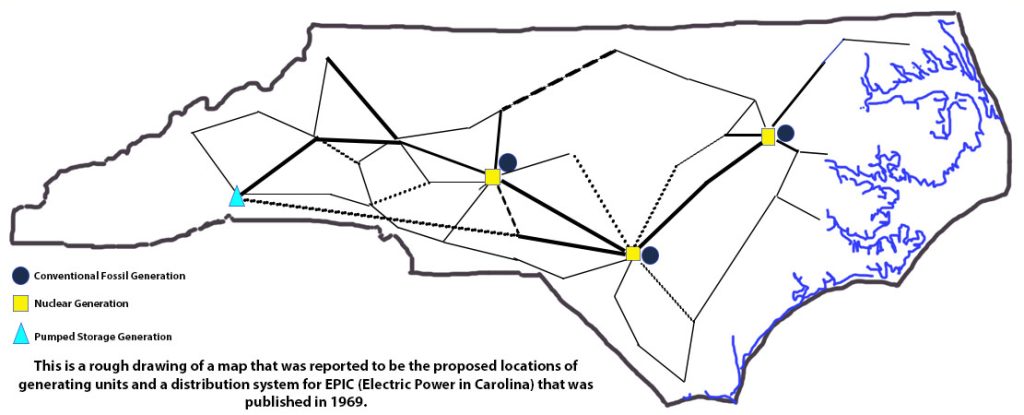
A look back at the city’s electric utility gives insight into the expansion of electric power in New Bern, NC.
Every election year, some politicians say New Bern has one of the lowest property tax rates east of Interstate 95, but they don’t mention the interfund transfers from the Electric Fund to the General Fund that support non-electric services and expenses. Wonder why?
NewBernNow.com created a timeline of significant events, moments and policies to help us better understand what’s happening now.
Public power in Eastern North Carolina
New Bern’s Department of Public Utilities team works around the clock to serve its customers inside and outside city limits. Depending on where you live in New Bern, the city’s public power utility may be your provider.
The early years
New Bern’s municipal power utility has been in the electric business for 123 years. The city owned and operated a power plant and sold electricity to its customers in 1902. As the city grew, a new plant was built at 205 First Street in 1947, (now the VOLT Center).
Sometime in the late 1950s or early 1960s, the city sold their electric generating units, bought their wholesale power supply from Carolina Power & Light Company, a for-profit, investor-owned utility, and sold the electricity to its customers at retail.
Electric Power in Carolina
In 1969, ElectriCities of North Carolina called for support of a $1 billion generation and transmission project to provide the long-range power needs of cities and rural cooperative in North Carolina, as reported here.
A group of electric cities and towns and electric membership co-operatives who owned electric distribution systems in North Carolina were working on a plan called Electric Power in Carolina (EPIC), as reported here. The goal was to provide power to cooperative and municipally owned distribution systems at a low cost by building, owning and operating generation and transmission facilities.

The plan was to build an electric supply system that included a nuclear plant in the coastal area, one nuclear plant and one coal-fired plant in the Piedmont and a pumped storage hydroelectric plant in the mountains with three substations linked by 500-KV transmission line, according to “North Carolina’s Public Power Systems Choose the ‘Hard’ Energy Path” by Margaret L. Hilton.
At the same time, private investor-owned utilities were considering joint ownership with public utilities systems as a source of low-interest financing.
In 1970, about 75 electric cities and electric membership cooperatives joined to form EPIC, a non-profit corporation.
Permits sought to construct nuclear power plant
In early 1971, Carolina Power & Light Co. applied for permits to construct a four-unit Shearon Harris Nuclear Power Plant in Wake and Chatham Counties. In May, the investor owned power company told customers in an advertisement that they asked for permission to increase their rates on an emergency basis. It said, “…People are using more electricity in their homes, and expanding industries and new industries, which create more jobs and new payrolls, will depend on us to supply the power they must have to operate. And electricity will be needed to run new devices for treating waste and reducing pollution in our air and water.” The ad said CP & L needed to raise rates so they could finance the new facilities. “…between now and 1978 we have already planned for facilities which will cost the staggering sum of $2,400,000,000” which “will come from people who are willing to invest their savings in CP & L.”
Oil Shock
In 1973, the United States faced an energy crisis, which led to a recession.
Lawmakers give municipal electric systems authority to jointly own power plants
In 1975, state law was passed that allowed municipal electric systems to jointly plan, build, and operate generation and transmission facilities. It also gave joint power agencies the authority to issue electric revenue bonds for projects, according to a CP & L document.
New Bern becomes a member of the North Carolina Municipal Power Agency 3
In January 1976, about 70 cities and towns formed North Carolina Municipal Power Agency 1, 2 and 3. New Bern became a member of NCMPA 3. As “bodies corporate and politic and instrumentalities” of the state, each municipal member appoints a commissioner to serve on a governing board of the Power Agency. The Power Agencies hired ElectriCities to manage contracts and provide administrative and other services.
Electric rates rise
In April 1976, the local newspaper reported that New Bern’s city council approved a 21 1/2 per cent increase in electric rates. The article said the ordinance hikes power rates by matching CP & L retail rates “with about a 10 per cent increase and adding an 11 1/2 per cent surcharge to those new rates. The hike was voted 4-0 with aldermen Tim Montgomery, Tom Davis, Gray Ingram and Ella Bengel all voting for the increase. Alderman Ben Hurst was absent.” After the vote, Mayor Charles Kimbrell said it was forced upon them. He said when adjustments are made in the wholesale costs, there must be adjustments in the retail cost,” the article said.
The article said City Manager JC Outlaw said the hike was expected to cover the 34.5 per cent increase in wholesale rates the city was facing. He estimated the increase at $1.2 million annually. He also said fuel adjustment charges were not included in the hike. “We will pass this on to customers.” He said, “As it’s billed to the city by CP&L.” The fossil fuel charges fluctuate month to month.
“CP & L was also charging a temporary 12-month fuel cost of 0.6-cent per kilowatt hour to cover deferred fuel charges lost when they switched from computing the fuel charges on a two-month lag to charging estimated fuel costs for the month of the billing,” the article said.
The article said the city manager said Morehead City and Jacksonville and other cities served by a utility “company is charged a franchise tax that goes into the city. He said, “It’s collected by the state and reverted to the local government agency.” The article said JC Outlaw said it was once charged by CP&L. “It’s recognized in state law for the utility to be taxed for the general fund of the city. The same principle is involved in this,” the article said.
Power Agencies allowed to own projects with co-ops and private utilities, issue municipal bonds
The state constitution was changed in 1977, which allowed municipal power agencies to jointly own generating or transmission projects with rural electric cooperatives and private utilities and issue municipal revenue bonds to finance projects.
Permits issued for construction of Shearon Harris Nuclear Power Plant
In 1978, the Nuclear Regulatory Commission Staff issued permits authorizing construction of four units at the Shearon Harris Nuclear Power Plant to Carolina Power & Light Company, according to documents on NRC.gov. It was estimated that Unit 1 would be “in commercial operation by 1984 with completion of the other three units in 1986, 1988 and 1990.”
New Bern agrees to purchase stake in generating units
Carolina Power & Light Co. needed money to complete the construction of power plants and the NCEMPA agreed to pay to construct the plants. New Bern’s Board of Aldermen agreed to the purchase a stake in CP & L’s generating units at nuclear and coal-fired power plants, some were under construction and others weren’t.
US faced an energy crisis; a nuclear accident also occurred
In 1979, the country faced another energy crisis, which led to a recession. Also, that year, a nuclear accident happened at Three Mile Island nuclear power near Middletown, Pa.
Negotiations continue
In 1980, news reported that NCMPA 3 said that the joint ownership negotiations between CP & L an the Power Agency continue. It was said that CP & L Co. would operate and fuel the plant, provide transmission service and sell all the supplemental power to the agency for “its participating cities need (over and above the amount of power they will receive from their share of the agency’s ownership interest).”
The article said, “As a tax-exempt municipal corporation, the agency can sell electric revenue bonds at an interest rate that is as much as 5 percent below what capital costs the private company.”
NCEMPA buys ownership shares in power plants
Fourteen NCMPA 2 members joined NCMPA 3 to form the North Carolina Eastern Municipal Power Agency in 1981. NCEMPA began purchasing ownership shares in seven power plants with Carolina Power & Light, including coal-fired and nuclear-powered units that were existing or under construction at the Brunswick Nuclear Plant, Roxboro Electric Generating Plant, Mayo Electric Generating Plant and Shearon Harris Nuclear Plant. The agency issued municipal bonds to borrow money from investors, and the proceeds were used to fund the purchase.
New Bern agrees to purchase all electric power from Municipal Power Agency
The North Carolina Eastern Municipal Power Agency members, including New Bern, agreed to purchase all of their electric power from the Power Agency. In return, New Bern’s municipal electric utility would receive a portion of its power needs at a membership rate.
A Purchase, Construction and Ownership Agreement dated July 1981 said the NCEMPA would sell capacity from the agency’s ownership interests in generating units to CP & L in declining amounts over a 15-year period. “Power Agency thereby retains increasing amounts of base load generation in each year during the term of the Purchased Capacity arrangement.”
The Power Agency “will have available assured power supply and transmission resources to provide the total all requirements bulk power supply needs of all members through the year 2032 or until the last Joint Unit is retired or decommissioned, whichever is later,” the document said.
The agreement said members were “obligated to take or pay for its entitlement share of power from any owned project, such as the Brunswick and Harris Units.”
The contract terms were for “the life of the project or so long as any of Power Agency’s bonds issued to finance the project are outstanding but not exceeding 50 years.”
The ownership offerings “included 19.7 percent for the Brunswick Units, 16.5 percent for the Harris Units and the Mayo Units, and 13.2 percent for Roxboro Unit No. 4. The project would “be financed through issuance of tax-exempt revenue bonds.”
“In the event that any Mayo Unit or Harris Unit is cancelled or decommissioned by CP&L prior to its date of commercial operation, Power Agency’s Ultimate Ownership Interest in the cancelled or decommissioned unit and all payment obligations related solely thereto will be reduced by 20 percent.”
The agreement said each municipal member “will fix and charge rates for electric service supplied from its Electric System sufficient to meet its obligations and to pay other amounts payable from such revenues including cost of operation and of any general obligation bonds issued by the municipality to finance its electric system.”
Nuclear plant cost estimated over $4 billion
In 1980, the total cost of the Shearon Harris Nuclear Plant was estimated at $4.4 billion, but the figure will be revised upward to account for delays, as reported here.
New Bern first began receiving power from NCEMPA in 1982.
Another Nuclear accident
In April 1986, a reactor at the Chernobyl Nuclear Power Plant exploded near Pripyat, Ukrainian SSR, now Ukraine.
New Bern’s resolution to support licensing and operation of nuclear power plant
In July 1986, Carolina Power & Light Co. sent a letter with resolutions from NCEMPA’s agency members that supported prompt licensing and operation of the Harris Plant to the NRC.
A resolution signed by Mayor Ella Bengel said, “the North Carolina Eastern Municipal Power Agency owns 16.17 percent of the Shearon Harris Nuclear Power Plant” and New Bern is a member.
“…the availability of an adequate supply of electricity is essential to create jobs, promote business development, and ensure the prosperity of the people of New Bern and Craven County, and” … the Harris Nuclear Plant will provide additional electricity to meet the current needs and the future needs.
The resolution said the city had confidence in the regulatory process and CP & L’s ability to operate the power plant “in a manner that will protect the health and safety of the people of New Bern and the State of North Carolina.”
“…any delay in the licensing and operation of the Harris Plant will result in substantial additional costs and will represent an unnecessary expense to the people of New Bern who are customers of City of New Bern and Craven County,” the resolution said.
Four nuclear reactors planned, one was built
Four nuclear reactors were planned for the Shearon Harris Nuclear Power Plant, but only one reactor was built. The plant began generating power in May 1987.
Board of Aldermen determine rates and establish policies
The director of the Department of Public Utilities runs the electric department and makes recommendations to the city manager who is the administrative head of the city. The manager makes recommendations to the Board of Aldermen who establishes the electric utility’s policies and approves the schedule of electric rates. The mayor presides at aldermen meetings and is the head of the city for ceremonial purposes (like ribbon cuttings). Prior to 2011, the mayor could vote on matters before the council when there was a tie. In 2011, three aldermen voted 3-2 on a resolution that asked the NC General Assembly to change the city charter so the mayor could vote on all matters before the board. A few months later, the charter was changed to allow the mayor to vote on all matters, as reported here.
Stay tuned for Part 2.
By Wendy Card, Editor. Send an email with questions or comments.

